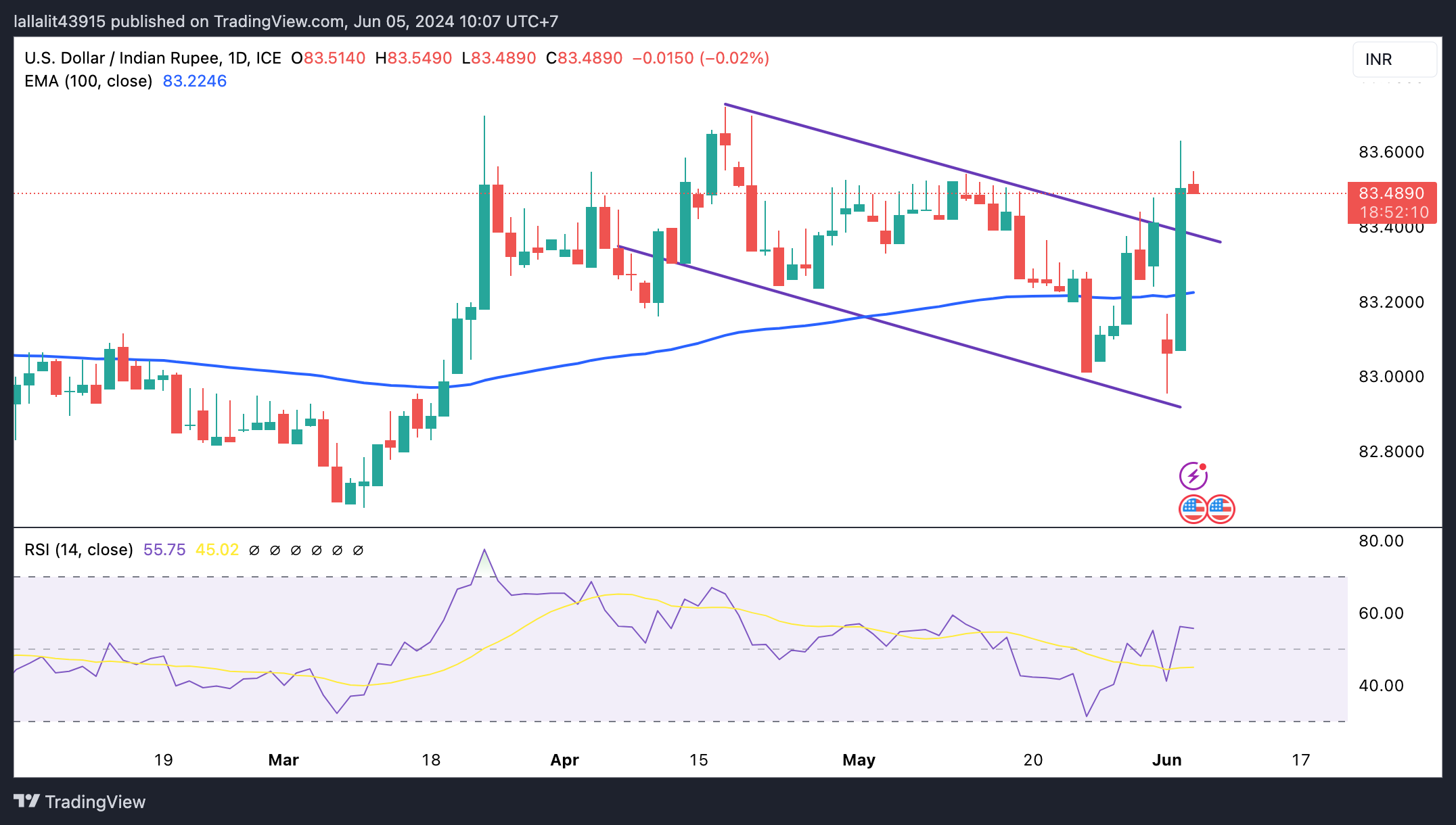Indian Rupee (INR) trades on a stronger note on Wednesday.
Lower oil prices and optimism about foreign fund inflows support the INR after facing the uncertainty surrounding Indian election.
Traders will closely watch the Indian HSBC Services PMI and US ISM Services PMI for May, which are due on Wednesday.
Indian Rupee (INR) recovers some lost ground on Wednesday after facing some selling pressure in the previous session. On Tuesday, the uncertainty surrounding a majority win for the BJP-led government triggered a significant sell-off in Indian equities and the INR. Nevertheless, the decline in crude oil prices and optimism about foreign fund inflows due to India’s inclusion in the JPMorgan bond indices are likely to support the Indian Rupee.
Investors will keep an eye on the Indian HSBC Services PMI, which is expected to rise to 61.4 in May from 60.8 in April. On the US docket, the US ISM Services PMI will be published, along with the ADP Employment Change. In case of the stronger-than-expected reading, this might boost the US Dollar (USD) and create a tailwind for the USD/INR pair.
Daily Digest Market Movers: Indian Rupee remains strong amid the uncertainties
Modi’s National Democratic Alliance (NDA) alliance won 292 seats combined, out of which his Bharatiya Janata Party (BJP) alone secured 240, per CNN.
Modi is set to negotiate with coalition partners in order to form a government. The BJP and its political allies, known as the National Democratic Alliance (NDA), have enough seats to form a majority government to rule for the next five years and return Modi to office for a third term, per the Guardian.
The NSE Nifty 50 closed down nearly 6% at 21,884.5 points on Tuesday, its steepest fall since India’s first Covid lockdowns in March 2020. The S&P BSE Sensex also fell sharply, closing 5.7% lower at 72,079.05.
The biggest fall for over four years for Indian stocks came after vote counting in India’s general election indicated Prime Minister Narendra Modi’s party might not be able to form a majority government, per BBC.
“USD-INR to stabilize around current levels in the near term; strong service exports, index flows and FX reserves to support INR,” said Standard Chartered Economist and FX Analyst Jonathan Koh
The US JOLTs Job Openings declined from 8.355 million to 8.059 million in April, below the market consensus of 8.34 million.
The final reading US ISM Services PMI is estimated to improve to 50.5 in May from 49.4 in April.
Technical analysis: USD/INR jumps above the descending trend channel on the daily chart
The Indian Rupee trades firmer on the day. The USD/INR pair has broken above the descending trend channel that has been established since mid-April and crossed back above the key 100-day Exponential Moving Average (EMA) on the daily chart, turning the outlook to the upside. Additionally, the 14-day Relative Strength Index (RSI) stands in bullish territory at around 55.80, and it supports buyers for the time being.
A high of June 4 at 83.62 acts as an immediate resistance level for the pair. Any follow-through buying will see a rally to a high of April 17 at 83.72 en route to the 84.00 psychological level.
On the downside, the resistance-turned-support level of 83.40 will be the first downside target for USD/INR. The next contention level to watch is the 100-day EMA at 83.20. A breach of this level will see a drop to the 83.00 round mark, followed by a low of January 15 at 82.78.

US Dollar price today
The table below shows the percentage change of US Dollar (USD) against listed major currencies today. US Dollar was the weakest against the Australian Dollar.
USD
EUR
GBP
CAD
AUD
JPY
NZD
CHF
USD
0.02%
-0.01%
-0.02%
-0.21%
0.26%
-0.21%
0.10%
EUR
-0.02%
-0.02%
-0.04%
-0.22%
0.27%
-0.21%
0.09%
GBP
0.02%
0.02%
-0.02%
-0.19%
0.30%
-0.19%
0.12%
CAD
0.02%
0.04%
0.01%
-0.18%
0.33%
-0.18%
0.14%
AUD
0.21%
0.22%
0.19%
0.19%
0.50%
0.00%
0.31%
JPY
-0.26%
-0.30%
-0.30%
-0.33%
-0.49%
-0.51%
-0.19%
NZD
0.21%
0.23%
0.20%
0.19%
0.00%
0.47%
0.31%
CHF
-0.10%
-0.09%
-0.11%
-0.13%
-0.30%
0.19%
-0.30%
The heat map shows percentage changes of major currencies against each other. The base currency is picked from the left column, while the quote currency is picked from the top row. For example, if you pick the Euro from the left column and move along the horizontal line to the Japanese Yen, the percentage change displayed in the box will represent EUR (base)/JPY (quote).
Indian economy FAQs
The Indian economy has averaged a growth rate of 6.13% between 2006 and 2023, which makes it one of the fastest growing in the world. India’s high growth has attracted a lot of foreign investment. This includes Foreign Direct Investment (FDI) into physical projects and Foreign Indirect Investment (FII) by foreign funds into Indian financial markets. The greater the level of investment, the higher the demand for the Rupee (INR). Fluctuations in Dollar-demand from Indian importers also impact INR.
India has to import a great deal of its Oil and gasoline so the price of Oil can have a direct impact on the Rupee. Oil is mostly traded in US Dollars (USD) on international markets so if the price of Oil rises, aggregate demand for USD increases and Indian importers have to sell more Rupees to meet that demand, which is depreciative for the Rupee.
Inflation has a complex effect on the Rupee. Ultimately it indicates an increase in money supply which reduces the Rupee’s overall value. Yet if it rises above the Reserve Bank of India’s (RBI) 4% target, the RBI will raise interest rates to bring it down by reducing credit. Higher interest rates, especially real rates (the difference between interest rates and inflation) strengthen the Rupee. They make India a more profitable place for international investors to park their money. A fall in inflation can be supportive of the Rupee. At the same time lower interest rates can have a depreciatory effect on the Rupee.
India has run a trade deficit for most of its recent history, indicating its imports outweigh its exports. Since the majority of international trade takes place in US Dollars, there are times – due to seasonal demand or order glut – where the high volume of imports leads to significant US Dollar- demand. During these periods the Rupee can weaken as it is heavily sold to meet the demand for Dollars. When markets experience increased volatility, the demand for US Dollars can also shoot up with a similarly negative effect on the Rupee.
Information on these pages contains forward-looking statements that involve risks and uncertainties. Markets and instruments profiled on this page are for informational purposes only and should not in any way come across as a recommendation to buy or sell in these assets. You should do your own thorough research before making any investment decisions. FXStreet does not in any way guarantee that this information is free from mistakes, errors, or material misstatements. It also does not guarantee that this information is of a timely nature. Investing in Open Markets involves a great deal of risk, including the loss of all or a portion of your investment, as well as emotional distress. All risks, losses and costs associated with investing, including total loss of principal, are your responsibility. The views and opinions expressed in this article are those of the authors and do not necessarily reflect the official policy or position of FXStreet nor its advertisers. The author will not be held responsible for information that is found at the end of links posted on this page.
If not otherwise explicitly mentioned in the body of the article, at the time of writing, the author has no position in any stock mentioned in this article and no business relationship with any company mentioned. The author has not received compensation for writing this article, other than from FXStreet.
FXStreet and the author do not provide personalized recommendations. The author makes no representations as to the accuracy, completeness, or suitability of this information. FXStreet and the author will not be liable for any errors, omissions or any losses, injuries or damages arising from this information and its display or use. Errors and omissions excepted.
The author and FXStreet are not registered investment advisors and nothing in this article is intended to be investment advice.
>>> Read full article>>>
Copyright for syndicated content belongs to the linked Source : FXStreet – https://www.fxstreet.com/news/usd-inr-loses-momentum-as-modi-declares-victory-in-india-election-202406050322






























